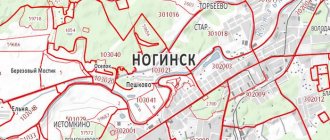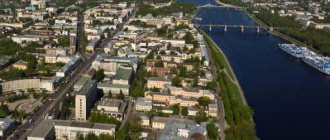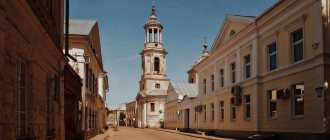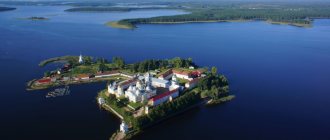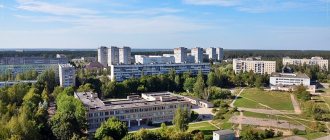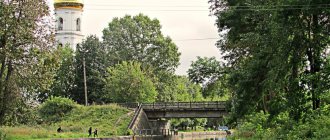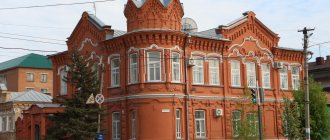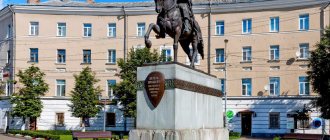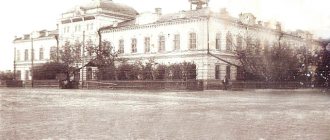City in Tver region, Russia
| Konakovo Konakovo | |
| City [1] | |
| Donkhovka River in Konakovo. May 2008 | |
| Flag Coat of arms | |
| Location of Konakovo | |
| Konakovo Location of Konakovo Show map of Russia Konakovo Konakovo (Tver region) Show map of Tver region | |
| Coordinates: 56°42'N 36°45'E / 56.700°N W. 36.750°E / 56,700; 36.750 Coordinates: 56°42'N 36°45'E. / 56.700°N W. 36.750°E / 56,700; 36,750 | |
| A country | Russia |
| Federal subject | Tver region [1] |
| Administrative region | Konakovsky district [2] |
| urban village | Konakovo [2] |
| Based | 1806 [3] |
| City status from | 1937 [3] |
| Height | 130 m (430 ft) |
| population size (2010 Census) [4] | |
| • General | 41 291 |
| • Evaluate (2018) [5] | 38 486 ( -6,8% ) |
| Administrative status | |
| • Capital from | Konakovsky district [6], urban settlement Konakovo [2] |
| Municipal status | |
| • Municipal district | Konakovsky municipal district [7] |
| • Urban village | Urban settlement Konakovo [7] |
| • Capital from | Konakovo municipal district [8], urban settlement Konakovo [7] |
| Timezone | UTC+3 (MSK[9]) |
| Postal code [10] | 171250–171256 |
| Dial code(s) | +7 48242 |
| OKTMO ID | 28630101001 |
| Web site | www.konakovo.in |
Konakovo
(Russian: Konakovo, IPA: [kənɐkovə]) is a city and administrative center in Konakovsky District in Tver Oblast, Russia, located on the right bank of the Ivankovo Reservoir (Volga River). Population: 41,291 (2010 census); [4] 42,335 (2002 census); [11] 42,522 people (1989 census). [12]
History[edit]
Konakovo faience factory
Konakovo was founded in 1806 as a village
in
Kuznetsovo
(Kuznetsovo).
[3] The name comes from the surname of Kuznetsov, who was one of the first owners. The village
was not very well, and was almost abandoned by 1820. [3] In 1826–1828, a faience factory was moved here from the village of Domkino, about 30 km east of Kuznetsov. [3] The plant was built by the merchant Auerbach in Domkino on land owned by a local landowner, and by 1829 the lease had expired and was not renewed. [3] In 1826, Auerbach bought all the lands in Kuznetsov and its environs. [3] In 1870, the factory was purchased by industrialist Matvey Kuznetsov (not related to Kuznetsov, who gave the village its name) and became known as the Kuznetsov Faience Factory. [3] After 1918, the factory was nationalized, and one of its specializations was the production of works of art. [3] To this end, he established collaborations with many famous Russian artists of the time. [3]
At that time, Kuznetsovo was part of Korchevskoy Uyezd in Tver Governorate. [13] On May 30, 1922, Korchevsky district was abolished and annexed to Kimry district. [14] On July 14, 1925, Kuznetsovo received the status of an urban-type settlement. [3]
On July 12, 1929, the Tver Governorate was abolished, and the territory was transferred to the Moscow Region. [14] The counties were abolished, and the Kuznetsovsky district, with its administrative center in the city of Korchev, was created in the Kimry district in the Moscow region. [14] On July 23, 1930, the districts were abolished, and the districts were directly subordinated to the region. [14] On February 26, 1930, Kuznetsovo was renamed Konakovo, and the Kuznetsovsky district was renamed Konakovsky, [14] in memory of Porfiry Konakov, a participant in the 1905 revolution. [3] January 29, 1935 The Kalinin region was formed, to which the Konakovsky district was transferred. [14] In 1937, when the Ivankovskoye Reservoir was filled, Korcheva found herself under water. [13] The administrative center of the district was transferred to Konakovo, which was given city status on March 2, 1937. [13] On February 13, 1963, during the failed administrative reform of Nikita Khrushchev, the Konakovsky district was merged with the Kalininsky district. , but on January 12, 1965 it was restored. [14] In 1990, the Kalinin region was renamed the Tver region. [ citation needed
]
The city of Konakovo is the administrative center of the Konakovsky district of the Tver region. Located on the banks of the Ivankovskoe reservoir on the Volga, 82 km southeast of Tver and 22 km from the M10 .
The population of the city is 39.5 thousand people.
Known since 1806 as the village of Kuznetsovo; named after one of the early owners of the village. In 1826-1828 landowner Auerbach moved a porcelain factory here from the village of Domkino (originally founded in 1809 by Friedrich Christian Brynner).
In 1821, an announcement appeared in the Moskovskie Vedomosti newspaper about the next sale in the Korchevsky district of the Tver province of the village of Kuznetsovo with the villages of “Belavina and Skrylyova / so in the document G.L. / Land was sold at 50 rubles per tithe / tithe is equal to 1.09 hectare. - G.L. /, and peasants 350 rubles per head.
This is how the landowner M. M. Rudakov acquired the village of Kuznetsovo, but he did not like the Kuznetsovo lands. In February 1824, a deal was concluded to sell Kuznetsov to a new owner, the widow of Lieutenant Chiari. But she, after a year and a half, is trying to get rid of this truly enchanted place.
The village of Kuznetsovo and the village of Belavino, offered for sale, are deserted. The peasants' winter grain disappeared under the snow, ownerless, and the peasant huts for the winter of 1825-1826 were left with boarded up doors and windows. Kuznetsovo was dying. And, probably, the lands around it would have turned into another wasteland if an event had not occurred that is characteristic of the contradictions between the moribund feudal system and capitalism getting back on its feet.
Twenty versts east of Kuznetsovo in the village of Domkino, a large at that time one of the first Russian earthenware factories, owned by the manufacturer A. Ya. Auerbach, had been operating for more than 15 years. His factory was built on land rented from the Korchevsky landowner F.L. Korobanov. The lease expired in 1829.
On January 14, 1826, a document on the purchase and sale of the village of Kuznetsov was drawn up.
Immediately after completing the purchase, Auerbach begins transporting his farm from Domkino to Kuznetsovo. A new stage in the history of the village of Kuznetsov begins.
In 1870, the porcelain and earthenware factory was purchased by the manufacturer M.S. Kuznetsov, owner of a number of porcelain factories. In 1870, the Auerbach faience factory became the property of Matvey Sidorovich Kuznetsov, who was the head of a large porcelain and faience company at that time, which united the Dulevskaya and Riga porcelain factories, as well as a factory in Volchya Polyana near Kharkov.
In 1898, the earthenware factory of the Joint Stock Company Maltsov Plants in the village of Pesochnya, Kaluga province (founded in 1851) was rented. In 1911, this factory became the property of the Kuznetsov “Partnership”. Thus, by the end of the 19th century M.S. Kuznetsov monopolizes porcelain and earthenware production and subordinates it to his influence.
Thus, the name of the village “coincided” with the surname of the owner of the plant, which was due to the widespread prevalence of the surname Kuznetsov, which is one of the most common in Russia.
Since the mid-1920s. The plant began to attract major artists to work on the shape and painting of vessels, whose works contributed to the overall rise in the artistic side of production.
The village of Kuznetsovo developed around the plant, which became a workers’ village on July 14, 1925.
In 1929, a new administrative division was introduced. The former Korchevsky district was divided into several districts. On the territory of the modern Konakovsky district, the Zavidovsky and Kuznetsovsky districts were formed.
The name “Kuznetsovo” was reminiscent of the previous owners, and it was decided to rename it, for which a competition was announced for the best name. At the suggestion of M.V. The village was named Ilyutina in honor of the revolutionary Porfiry Petrovich Konakov.
By the resolution of the Presidium of the All-Russian Central Executive Committee of December 30, 1929 and the Central Executive Committee of the USSR of February 26, 1930, Kuznetsovo and the region received new names: “ Konakovo ” and “Konakovsky ”.
The largest settlement in the region remained Konakovo , whose population in 1935 reached 7 thousand people.
And already in 1937 Konakovo received city status. In the same year, a railway line was opened connecting it with the Oktyabrskaya Railway. Konakovo has turned into a large industrial and transport center.
In 1945, an art and craft school was opened Konakovo The school operated until 1954.
Today, the city’s economy consists of: Konakovo State District Power Plant, Konakovo Faience Factory, Konakovo Power Tools Plant, Konakovo Steel Structures Plant, production of building materials, Konakovo Bakery Plant, Konakovo Dairy Plant, etc.
In Konakovo Donkhovka River flows into the Volga , and on the left, near the village of Ustye, is the Soz , flowing from Lake Velikoye .
One of the most significant attractions of the city of Konakovo is the ancient forest .
In 1999, the earthenware factory, founded in 1809 by the Bohemian pharmacist Friedrich Christian Brynner, celebrated its 190th anniversary. Since 1829, it began to belong to the Auerbach family of Russian landowners. In 1869, the plant was bought by the largest magnate of the porcelain and earthenware industry, Matvey Sidorovich Kuznetsov, “the king of Russian porcelain.” The oldest building of the plant - the 7th forge - a workshop for unique and small-scale products , built in 1883, is a historical monument.
In a pine forest (within the city) at the confluence of the river. Donkhovka with the Volga on the shore there is a dacha (complex) - architect Gautier , built at the end of the 19th - beginning of the 20th century. This estate is an architectural monument.
In the old part of the city, on the left bank of the Donkhovka , there is an unusual building of original architecture. It was erected in the period from 1907 to 1912, when new buildings were being built at the Tver Porcelain and Earthenware Factory (now JSC Konakovo Faience Factory). Engineer N.A. Loturaev designed and supervised the construction of the building. The architecture of the building corresponds to the trends characteristic of the period of decline of Russian Art Nouveau.
The Kuznetsovsky cinema was the only one in the entire Korchev district and one of the first provincial cinemas in Russia opened in a building specially built for this purpose.
The organizational decision to create a city museum was made by the executive committee of the city council in 1979. With the support of the city party committee, they allocated premises for the museum in house No. 11 on the street. Power engineers.
Telephone code: +7 48242
Official website of the City Administration: www.konakovo.in
Economics [edit]
Konakovskaya GRES
Konakovskaya GRES, a thermal power plant, is the largest enterprise in the Konakovo district. In 2008, it produced more than 60% of the district's GDP. [15]
Transport[edit]
In Konakovo there is a railway station Konakovskaya GRES. It is connected to the St. Petersburg-Moscow railway by a branch line to Reshetnikovo. Connected by regular passenger commuter services to Moscow.
Konakovo has road connections with Kimry and Zavidovo, where it has access to the M10 motorway, which runs between Moscow and Saint Petersburg. There are also local roads with bus service.
Links[edit]
Notes[edit]
- ^ ab Law No. 34-ZO
- ^ abcd Law No. 34-ZO establishes that the boundaries of settlements (administrative territorial units) are identical to the boundaries of urban and rural settlements (municipalities), and the boundaries of administrative districts are identical to the boundaries of municipal districts. In Law No. 31-ZO, which defines the boundaries and composition of the municipalities of the Konakovo municipal district, the city of Konakovo is included in the composition and administrative center of the urban settlement of Konakovo in this district.
- ^ B s d e g h i JKL History of the city of Konakovo (in Russian). Official website of the Konakovo administration. Retrieved July 13, 2015.
- ^ a b Federal State Statistics Service (2011). “All-Russian Population Census 2010. Volume 1" [All-Russian Population Census 2010, vol. 1]. All-Russian Population Census 2010 [All-Russian Population Census 2010]
. Federal State Statistics Service. - "26. The size of the permanent population of the Russian Federation by municipalities as of January 1, 2022". Federal State Statistics Service. Retrieved January 23, 2022.
- ^ ab State Committee of the Russian Federation on Statistics. Committee of the Russian Federation for Standardization, Metrology and Certification. No. OK 019-95 January 1, 1997 “All-Russian classifier of objects of administrative-territorial division. Code 28 230", ed. changes No. 278 / 2015 dated January 1, 2016. (Goskomstat of the Russian Federation. Committee of the Russian Federation for Standardization, Metrology and Certification. No. OK 019-95 January 1, 1997. Russian classification of administrative divisions) (OKATO).
Code 28 230 as amended by Amendment No. 278/2015 dated 01/01/2016). - ^ abcd Law No. 31-ZO
- Law No. 4-ZO
- "On the Calculation of Time". Official Internet portal of legal information
. June 3, 2011. Retrieved January 19, 2022. - Post office. Information and computing center of OASU RPO. ( Post office
).
Search for postal service objects ( postal Search for objects
) (in Russian) - ↑
Federal State Statistics Service of Russia (May 21, 2004).
“The population of Russia, the constituent entities of the Russian Federation as part of federal districts, urban settlements, settlements, settlements of 3 thousand or more people” [Population of Russia, its federal districts, federal districts, districts, urban settlements, rural settlements - administrative centers and rural settlements with a population of more than 3000] (XLS). All-Russian Population Census of 2002 [All-Russian Population Census of 2002]
. - “All-Union Population Census of 1989. The current population of union and autonomous republics, autonomous regions and districts, territories, negative phenomena, urban settlements and rural district centers” [All-Union Population Census of 1989: current population of union and autonomous republics, Autonomous regions and districts , territories, regions, districts, urban settlements, villages performing the functions of district administrative centers. All-Union Population Census of 1989 [All-Union Population Census of 1989]
.
Institute of Demography of the National Research University: Higher School of Economics [Institute of Demography of the National Research University: Higher School of Economics]. 1989 - via Demoscope Weekly
. - ^ a b c About the area (in Russian). Official website of the Konakovsky district administration. Retrieved July 13, 2015.
- ^ B s d e g Information about changes in the administrative-territorial division of the Tver region - Kalinin region (in Russian). Archives of Russia. Archived from the original on April 19, 2012. Retrieved July 13, 2015.
- Socio-economic situation (in Russian). Konakovo district administration. Retrieved August 25, 2014.
- Monuments of history and culture of the peoples of the Russian Federation (in Russian). Ministry of Culture of Russia. Retrieved June 2, 2016.
- Konakovo Museum of Local Lore (in Russian). Russian Cultural Heritage Network. Retrieved August 27, 2014.
Konakovsky municipal district of Tver region -
According to the All-Russian Population Census, which was conducted in 2010, a total of 87,125 people (38,813 men and 48,312 women) live in the Konakovsky district. Including children and adolescents - 12,610 (6,441 boys and 6,169 girls), working age - 49,958 (25,696 men and 24,262 women), pensioners - 24,556 (6,675 men and 17,881 women). The population of the Konakovsky district decreased by 5.3% compared to the 2002 census (for reference: in the region as a whole the decrease was 8.0%).
In terms of population, Konakovsky District ranks 1st in the Tver Region among municipal districts. The share of district residents in the total population of the region is 6.4%.
The majority of the district's population, 67,667 people or 77.7%, lives in the city of Konakovo and the urban-type settlements of Izoplit, Kozlovo, Novozavidovsky, Radchenko, Redkino (in the region as a whole, the share of urban residents is 74.7%), 19,462 live in rural settlements of the district person or 22.3% (in the region as a whole, the share of rural residents is 25.3%).
On the territory of the Konakovsky district there are 181 rural settlements, of which 11 are large, with a population of 500 people or more, or 6.1% (the regional average is 1.1%). In 59 rural settlements of the district, from 6 to 25 people live, or 32.6% (regional average 30.7%). In 34 rural settlements of the district, from 1 to 5 people live, or 18.8% (the regional average is 24.7%). 16 rural settlements of the district or 8.8% are empty (regional average - 23.4%)
As in the Tver region as a whole, in the Konakovo district the number of female population prevails over the male population. For every 1,000 men in the region as a whole, there are 1,245 women (regional average 1,215), including among the urban population - 1,263 (regional average - 1,249), and among the rural population - 1,184 (regional average 1,121).
Compared to the 2002 census, the population of the Konakovsky district has aged by 1.1 years. The average age of residents is 42.1 years (Tver region - 41.5 years). The average age of the urban population of the district is 42.1 years (the regional average is 41.0), the rural population is 41.9 years (the regional average is 43.0). 57.3% of the district's population are people of working age (the average for the region is 59.2%), 14.5% are people under working age (the average for the region is 14.4%), 28.2% are people over working age (in the average for the region is 26.45).
If we distribute the population of the region among urban and rural settlements, then the following picture emerges.
Urban settlement Konakovo - 42,094 inhabitants (18,598 men and 23,496 women). At the same time, the urban population was 41,291 (18,241 men and 23,050 women), the rural population was 803 (357 men and 446 women).
Urban settlement Izoplit village - 3925 inhabitants (1660 men and 2265 women), including an urban population of 1769 people (732 men and 1037 women), a rural population - 2156 inhabitants (928 men and 1228 women).
Urban settlement Kozlovo village - 3884 inhabitants (1798 men and 2086 women).
Urban settlement Novozavidovsky settlement - 7769 inhabitants (3487 men and 4282 women), including the urban population - 7479 people (3343 men and 4136 women), the rural population - 290 people (144 men and 146 women).
Urban settlement Radchenko village - 1853 residents (811 men and 1046 women), including urban population - 1537 people (678 men and 859 women), rural population - 320 people (133 men and 187 women).
Urban settlement Redkino village - 11,703 inhabitants (5,110 men and 6,593 women).
Vakhoninsky rural settlement - 1473 inhabitants (692 men and 791 women).
Gorodensky rural settlement - 2593 inhabitants (1166 men and 1427 women).
Dmitrovogorsk rural settlement - 1526 inhabitants (703 men and 823 women).
Zavidovo rural settlement - 1602 inhabitants (763 men and 839 women).
Moksha rural settlement - 2378 inhabitants (1059 men and 1319 women).
Pervomaiskoe rural settlement - 1237 inhabitants (574 men and 663 women).
Ruchyevskoye rural settlement – 992 inhabitants (469 men and 523 women).
Selikhovskoye rural settlement - 1855 inhabitants (874 men and 981 women).
Staromelkivskoye rural settlement - 1202 inhabitants (540 men and 662 women).
Yuryevo-Devichyevskoye rural settlement - 722 inhabitants (354 men and 368 women).
Kozlovskoye rural settlement - 313 inhabitants (155 men and 158 women).
